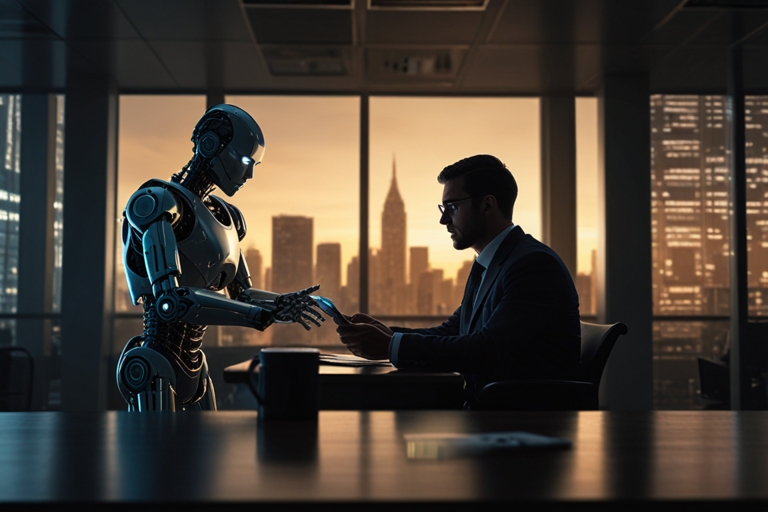
TL;DR
- Amazon CEO Andy Jassy warned staff that AI will replace some jobs within the next few years, echoing a common trend among tech CEOs to use AI as a tool to maintain workforce control.
- Anthropic CEO Dario Amodei claimed AI could eliminate half of all entry-level white-collar jobs in five years, a statement contested by other AI leaders like Nvidia’s Jensen Huang.
- Despite fears, experts note AI still struggles with physical tasks and that the hype often overshadows practical limits of generative AI.
- Workplace tech innovations, including AI, often increase employee pressure and extend work hours, exemplified by Microsoft’s findings on “infinite workday” stress.
AI and Job Fears: The New CEO Playbook
In the ongoing saga of artificial intelligence’s impact on jobs, a recent memo from Amazon CEO Andy Jassy has stirred conversations about the future of work. Jassy’s internal note to employees titled “Some thoughts on Generative AI” highlights Amazon’s AI advancements like making Alexa smarter and improving customer service chatbots. Yet buried deep in the message was a blunt warning: AI “agents” will replace some Amazon workers in the coming years, leading to an expected reduction in corporate workforce.
This tactic of using AI-induced job fears to motivate or control employees is hardly new. As CNN reported, Jassy’s announcement is part of a broader pattern where tech executives amplify AI’s disruptive potential to maintain pressure on staff.
The Anthropic Prediction and Industry Pushback
Anthropic CEO Dario Amodei raised the stakes further by claiming AI might wipe out half of all entry-level white-collar jobs in five years. His dramatic forecast has been met with skepticism by peers. Nvidia CEO Jensen Huang and Google DeepMind’s Demis Hassabis have publicly pushed back, emphasizing AI’s limitations and potential rather than apocalyptic disruption.
The Reality Behind the AI Hype
While generative AI technologies like large language models impress with their ability to produce human-like text and assist in complex tasks, they remain far from replacing many human jobs outright. They often hallucinate or produce errors and require extensive human supervision.
Critically, current AI struggles with physical tasks such as manual labor, assembly, or any job requiring dexterity — areas where human workers remain irreplaceable.
The Uneven Burden of AI Job Automation
A notable omission from CEO memos is any indication that executives themselves face risk from AI. The threat tends to be directed downward, focusing on entry-level or middle-tier roles rather than leadership.
This selective messaging serves to instill uncertainty among staff and maintain hierarchical control while positioning AI as an inevitable force.
Workplace Tech and the “Infinite Workday”
Adding to employee stress is the legacy of workplace tech innovations meant to improve flexibility but often leading to burnout. Tools like email, Slack, Teams, and Zoom have created an “always-on” culture.
A recent Microsoft report highlights that office workers now receive hundreds of emails, instant messages, and meeting invites daily, leading to constant interruptions — about every two minutes during work hours.
Microsoft’s solution ironically involves AI agents, suggesting a future where AI manages not only workflows but also the pace and pressure of work.
AI and Job Market Impact – Industry Insights
| Fact | Detail | Source |
| Amazon warns workforce cuts due to AI | Workforce expected to reduce with AI-driven efficiency gains | CNN report on Amazon AI jobs |
| Anthropic prediction of job losses | Up to 50% of entry-level white-collar jobs eliminated in 5 years | CNN interview with Dario Amodei |
| Microsoft “infinite workday” interruptions | 275 work interruptions per day due to emails, chats, meetings | Microsoft Work Trend Index |
| AI physical task limitations | AI unable to perform many manual and dexterous tasks | Industry expert analyses |
Conclusion: Balancing AI Potential and Workforce Realities
The chorus of AI job warnings from CEOs like Andy Jassy and Dario Amodei underscores the disruptive potential of AI but also serves as a strategy to keep employees cautious and motivated. Meanwhile, industry leaders like Nvidia offer a more tempered outlook on AI’s capabilities and timeline.
It remains crucial for workers, managers, and policymakers to critically assess AI’s true impact, recognize its current limits, and prepare for a future where AI enhances productivity without unjust workforce disruption. The cultural shifts triggered by AI and workplace tech call for thoughtful regulation and employee protection to avoid exacerbating burnout or job insecurity.






